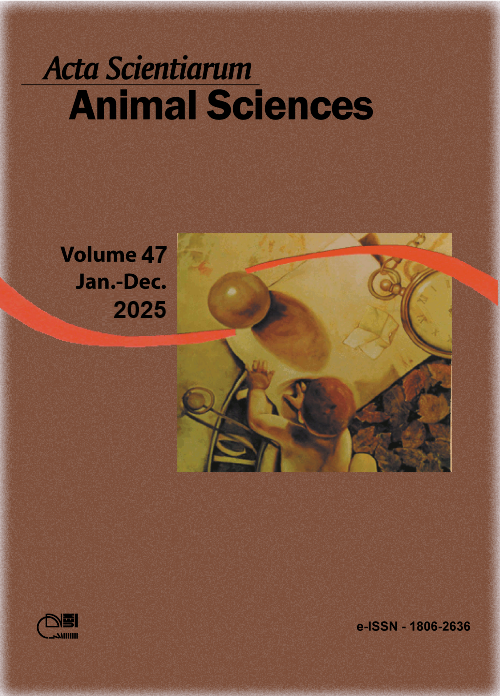Next generation sequencing and bio-informatics analysis for the investigation of the vaginal bacterial microflora of clinically healthy mares
Resumo
This study was focused on the investigation of the constitution of the vaginal bacterial microflora of mares, using 16Sr-RNA next generation sequencing and bio-informatics analysis. Samples were collected from the inner vaginal wall of 30 clinically healthy adult mares from various locations in central Greece. Successful reads were retrieved from 28 samples resulting to the presumptive identification of 192 bacterial species belonging to 87 genera. None of the bacterial genera or species that were detected was present in all the test samples, which indicates that the vaginal bacterial microflora of the study population is diverse. The bacterial genera detected the most in the test samples were Staphylococcus (89%) and Acinetobacter (54%). The bio-informatics analysis produced evidence of a much richer microbiota for the Greek native, compared to the Arabian and other breeds, and indicated variations in its constitution associated with the reproduction and vaccination records.
Downloads
Referências
Adnane, M., & Chapwanya, A. (2022). Role of Genital Tract Bacteria in Promoting Endometrial Health in Cattle. Microorganisms, 10(11), 2238. https://doi.org/10.3390/microorganisms10112238.
Appiah, M. O., Wang, J., & Lu, W. (2020). Microflora in the Reproductive Tract of Cattle: A Review. Agriculture, 10(6), 232. https://doi.org/10.3390/agriculture10060232
Barba, M., Martínez-Boví, R., Quereda, J. J., Mocé, M. L., Plaza-Dávila, M., Jiménez-Trigos, E., Gómez-Martín, Á., González-Torres, P., Carbonetto, B., & García-Roselló, E. (2020). Vaginal Microbiota Is Stable throughout the Estrous Cycle in Arabian Maress. Animals, 10(11), 2020. https://doi.org/10.3390/ani10112020
Ciabattini, A., Olivieri, R., Lazzeri, E., & Medaglini, D. (2019). Role of the Microbiota in the Modulation of Vaccine Immune Responses. Frontiers in Microbiology, 10. https://doi.org/10.3389/fmicb.2019.01305
Husso, A., Jalanka, J., Alipour, M. J., Huhti, P., Kareskoski, M., Pessa-Morikawa, T., Iivanainen, A., & Niku, M. (2020). The composition of the perinatal intestinal microbiota in horse. Scientific reports, 10(1). https://doi.org/10.1038/s41598-019-57003-8
Jamieson, A.M. (2015). Influence of the microbiome on response to vaccination. Human Vaccines & Immunotherapeutics, 11(9), 2329–2331. https://doi.org/10.1080/21645515.2015.1022699.
Jašarević, E., Hill, E. M., Kane, P. J., Rutt, L., Gyles, T., Folts, L., Rock, K. D., Howard, C. D., Morrison, K. E., Ravel, J., & Bale, T. L. (2021). The composition of human vaginal microbiota transferred at birth affects offspring health in a mouse model. Nature communications, 12(1). https://doi.org/10.1038/s41467-021-26634-9
Klein-Jöbstl, D., Quijada, N. M., Dzieciol, M., Feldbacher, B., Wagner, M., Drillich, M., Schmitz-Esser, S., & Mann, E. (2019). Microbiota of newborn calves and their mothers reveals possible transfer routes for newborn calves' gastrointestinal microbiota. PloS one, 14(8), e0220554. https://doi.org/10.1371/journal.pone.0220554
Lynn, M. A., Tumes, D. J., Choo, J. M., Sribnaia, A., Blake, S. J., Leong, L. E. X., Young, G. P., Marshall, H. S., Wesselingh, S. L., Rogers, G. B., & Lynn, D. J. (2018). Early-Life Antibiotic-Driven Dysbiosis Leads to Dysregulated Vaccine Immune Responses in Mice. Cell host & microbe, 23(5), 653–660.e5. https://doi.org/10.1016/j.chom.2018.04.009
Malaluang, P., Wilén, E., Frosth, S., Lindahl, J., Hansson, I., & Morrell, J.M. (2022). Vaginal Bacteria in Mares and the Occurrence of Antimicrobial Resistance. Microorganisms, 10(11). https://doi.org/10.3390/microorganisms10112204.
Uchihashi, M., Bergin, I.L., Bassis, C.M., Hashway, S.A., Chai, D., & Bell, J.D. (2015). Influence of age, reproductive cycling status, and menstruation on the vaginal microbiome in baboons (Papio anubis). American Journal of Primatology, 77(5), 563–578. https://doi.org/10.1002/ajp.22378.
Yildirim, S., Yeoman, C. J., Janga, S. C., Thomas, S. M., Ho, M., Leigh, S. R., Primate Microbiome Consortium, White, B. A., Wilson, B. A., & Stumpf, R. M. (2014). Primate vaginal microbiomes exhibit species specificity without universal Lactobacillus dominance. The ISME Journal, 8(12), 2431–2444. https://doi.org/10.1038/ismej.2014.90
Zimmermann, P., & Curtis, N. (2018). The influence of the intestinal microbiome on vaccine responses. Vaccine, 36, 4433–4439. https://doi.org/10.1016/j.vaccine.2018.04.
DECLARAÇÃO DE ORIGINALIDADE E DIREITOS AUTORAIS
Declaro que o presente artigo é original, não tendo sido submetido à publicação em qualquer outro periódico nacional ou internacional, quer seja em parte ou em sua totalidade.
Os direitos autorais pertencem exclusivamente aos autores. Os direitos de licenciamento utilizados pelo periódico é a licença Creative Commons Attribution 4.0 (CC BY 4.0): são permitidos o compartilhamento (cópia e distribuição do material em qualqer meio ou formato) e adaptação (remix, transformação e criação de material a partir do conteúdo assim licenciado para quaisquer fins, inclusive comerciais.
Recomenda-se a leitura desse link para maiores informações sobre o tema: fornecimento de créditos e referências de forma correta, entre outros detalhes cruciais para uso adequado do material licenciado.








































